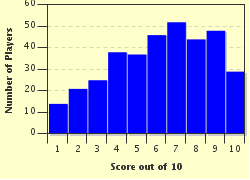Quiz Answer Key and Fun Facts
1. In 1851, within days of the establishment of Victoria as a state separate from New South Wales, Louis Michel made the state's official first discovery of gold at Anderson's Creek, northeast of Melbourne. In what modern town did this occur?
2. Prospective miners flocked to the goldfields, most of them passing through Melbourne on their way. This picture shows a tent city in South Melbourne, with the main city visible across the bay. From a population of approximately 80,000 people (and six million sheep) when the state was established, to what approximate size had Victoria grown by 1854, a mere three years later?
3. One of the first 'rushes' in Victoria followed the discovery of specks of gold in Specimen Gully, part of a property known as Mount Alexander Station, on 20 July 1851. What contemporary (unfortified) city was established as a result?
4. After the discovery of gold in Bendigo, the area attracted a large influx of Chinese miners, who established a Chinatown district near one of the more fruitful mining sites. What was the most common attitude of miners from a European background to the Chinese miners?
5. The first miners in the Victorian gold rush simply collected visible nuggets. This was followed by various methods such as panning (shown in the picture) to remove (usually small) pieces of gold that were mixed in with the other components of the dirt and gravel. What is the name for this type of gold field?
6. Once the easily-obtained surface gold had been exhausted, miners turned to developing techniques for obtaining gold that was enclosed in the underlying rocks. What is the name for this type of gold deposit?
7. The move to underground mining, especially in Bendigo and Ballarat, led to an increased concentration of miners in these area, and frequent tensions between miners and policing authorities, who mostly seemed more interested in making sure that miners had paid their license fees than in maintaining order and safety on the fields. These tensions culminated in what 1854 event?
8. The miners in Ballarat who defied colonial authorities fought under a blue flag with a white cross on which appear five stars, representing the constellation Crux. By what name is this flag, like the constellation featured on it, usually known?
9. In 1869, near the end of the gold rush period, John Deason and Richard Oates were very happy to greet what was then the largest alluvial gold nugget in the world. What name was given to this monster nugget, which measured roughly 60 cm by 30 cm (24 in by 12 in)?
10. Which of the following is a tourist site that allows visitors to see what life in Ballarat was like during the 1850s?
Source: Author
looney_tunes
This quiz was reviewed by FunTrivia editor
bloomsby before going online.
Any errors found in FunTrivia content are routinely corrected through our feedback system.

